Page 1561 of 3171
FRONT FINAL DRIVE ASSEMBLY
FFD-15
C
E
F
G
H
I
J
K
L
MA
B
FFD
FRONT FINAL DRIVE ASSEMBLYPFP:38500
Removal and InstallationEDS00356
REMOVAL
1. Remove the front wheels and tires using power tool.
2. Without disassembling the hydraulic lines, remove the caliper torque member bolts using power tool.
Then reposition the brake caliper aside using suitable wire. Refer toBR-26, "
Removal and Installation of
Brake Caliper Assembly".
CAUTION:
Do not press the brake pedal while brake caliper is removed.
3. Remove the ABS sensor harness from the mount on the knuckle.
1. Breather hose 2. Front final drive assembly 3. Front crossmember
4. Engine under cover rear
PDIA1035E
Page 1562 of 3171
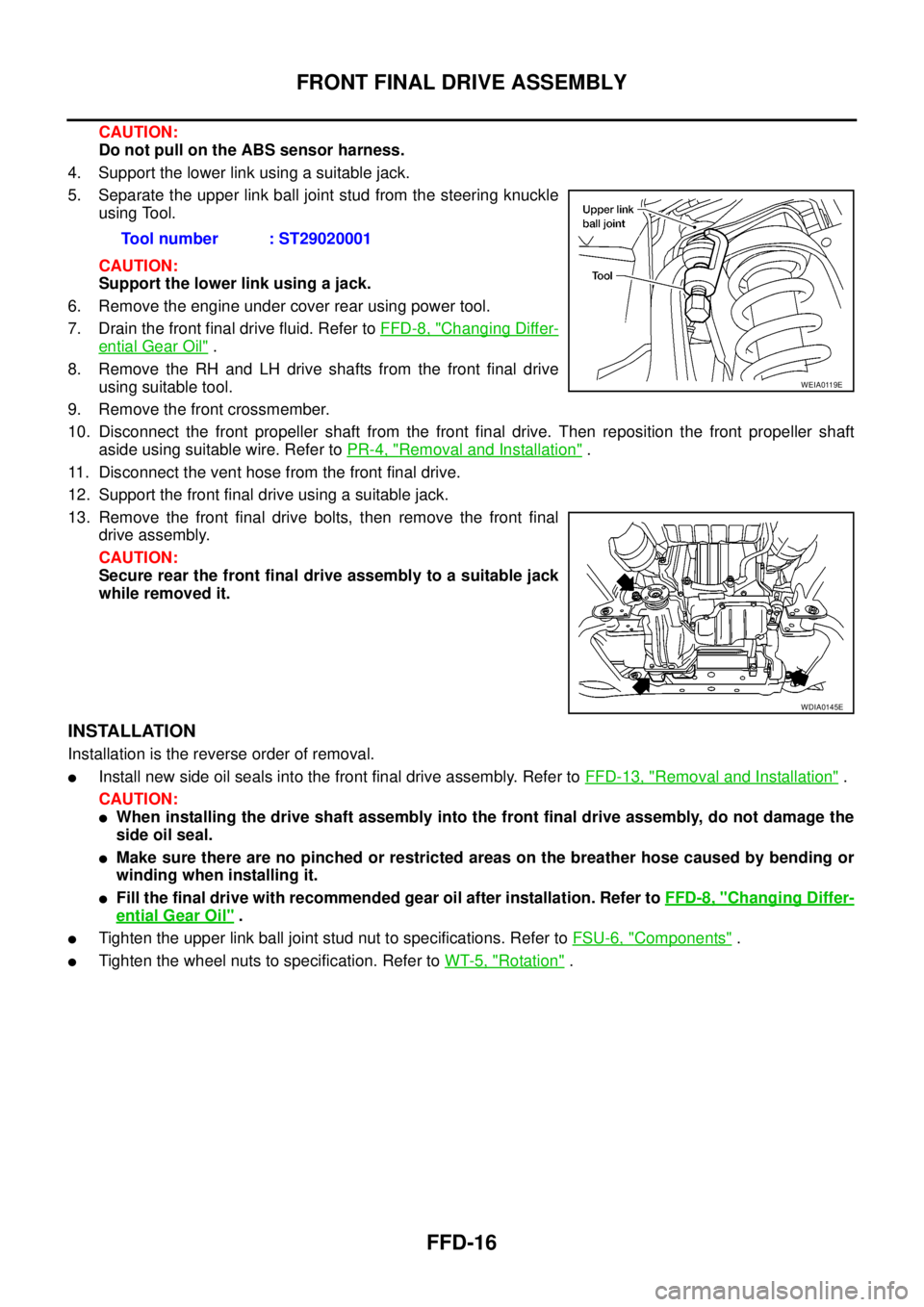
FFD-16
FRONT FINAL DRIVE ASSEMBLY
CAUTION:
Do not pull on the ABS sensor harness.
4. Support the lower link using a suitable jack.
5. Separate the upper link ball joint stud from the steering knuckle
using Tool.
CAUTION:
Support the lower link using a jack.
6. Remove the engine under cover rear using power tool.
7. Drain the front final drive fluid. Refer toFFD-8, "
Changing Differ-
ential Gear Oil".
8. Remove the RH and LH drive shafts from the front final drive
using suitable tool.
9. Remove the front crossmember.
10. Disconnect the front propeller shaft from the front final drive. Then reposition the front propeller shaft
aside using suitable wire. Refer toPR-4, "
Removal and Installation".
11. Disconnect the vent hose from the front final drive.
12. Support the front final drive using a suitable jack.
13. Remove the front final drive bolts, then remove the front final
drive assembly.
CAUTION:
Secure rear the front final drive assembly to a suitable jack
while removed it.
INSTALLATION
Installation is the reverse order of removal.
lInstall new side oil seals into the front final drive assembly. Refer toFFD-13, "Removal and Installation".
CAUTION:
lWhen installing the drive shaft assembly into the front final drive assembly, do not damage the
side oil seal.
lMake sure there are no pinched or restricted areas on the breather hose caused by bending or
winding when installing it.
lFill the final drive with recommended gear oil after installation. Refer toFFD-8, "Changing Differ-
ential Gear Oil".
lTighten the upper link ball joint stud nut to specifications. Refer toFSU-6, "Components".
lTighten the wheel nuts to specification. Refer toWT-5, "Rotation". Tool number : ST29020001
WEIA0119E
WDIA0145E
Page 1585 of 3171
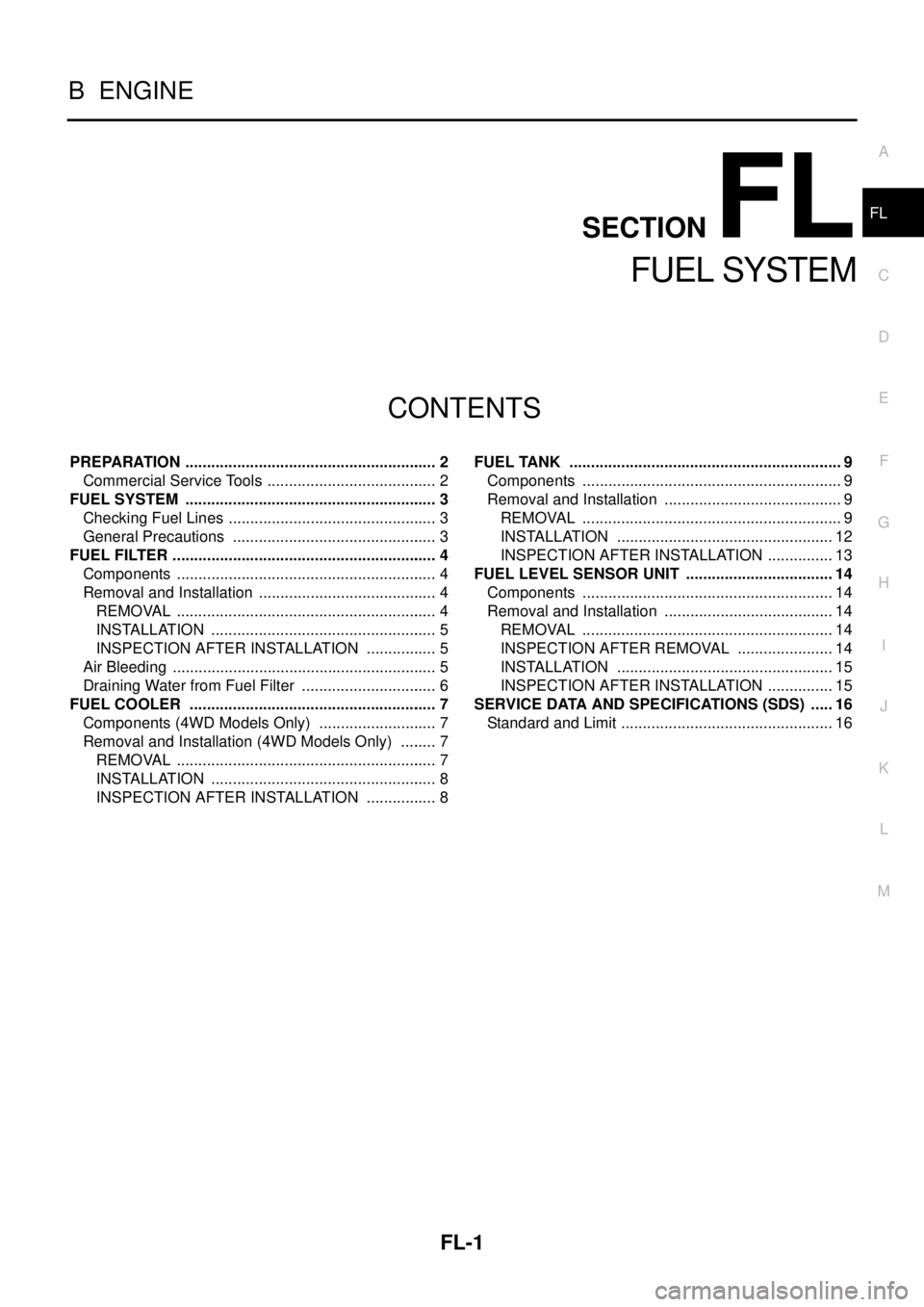
FL-1
FUEL SYSTEM
B ENGINE
CONTENTS
C
D
E
F
G
H
I
J
K
L
M
SECTIONFL
A
FL
FUEL SYSTEM
PREPARATION ........................................................... 2
Commercial Service Tools ........................................ 2
FUEL SYSTEM ........................................................... 3
Checking Fuel Lines ................................................. 3
General Precautions ................................................ 3
FUEL FILTER .............................................................. 4
Components ............................................................. 4
Removal and Installation .......................................... 4
REMOVAL ............................................................. 4
INSTALLATION ..................................................... 5
INSPECTION AFTER INSTALLATION ................. 5
Air Bleeding .............................................................. 5
Draining Water from Fuel Filter ................................ 6
FUEL COOLER .......................................................... 7
Components (4WD Models Only) ............................ 7
Removal and Installation (4WD Models Only) ......... 7
REMOVAL ............................................................. 7
INSTALLATION ..................................................... 8
INSPECTION AFTER INSTALLATION ................. 8FUEL TANK ................................................................ 9
Components ............................................................. 9
Removal and Installation .......................................... 9
REMOVAL ............................................................. 9
INSTALLATION ................................................... 12
INSPECTION AFTER INSTALLATION ................ 13
FUEL LEVEL SENSOR UNIT ................................... 14
Components ........................................................... 14
Removal and Installation ........................................ 14
REMOVAL ........................................................... 14
INSPECTION AFTER REMOVAL ....................... 14
INSTALLATION ................................................... 15
INSPECTION AFTER INSTALLATION ................ 15
SERVICE DATA AND SPECIFICATIONS (SDS) ...... 16
Standard and Limit .................................................. 16
Page 1594 of 3171
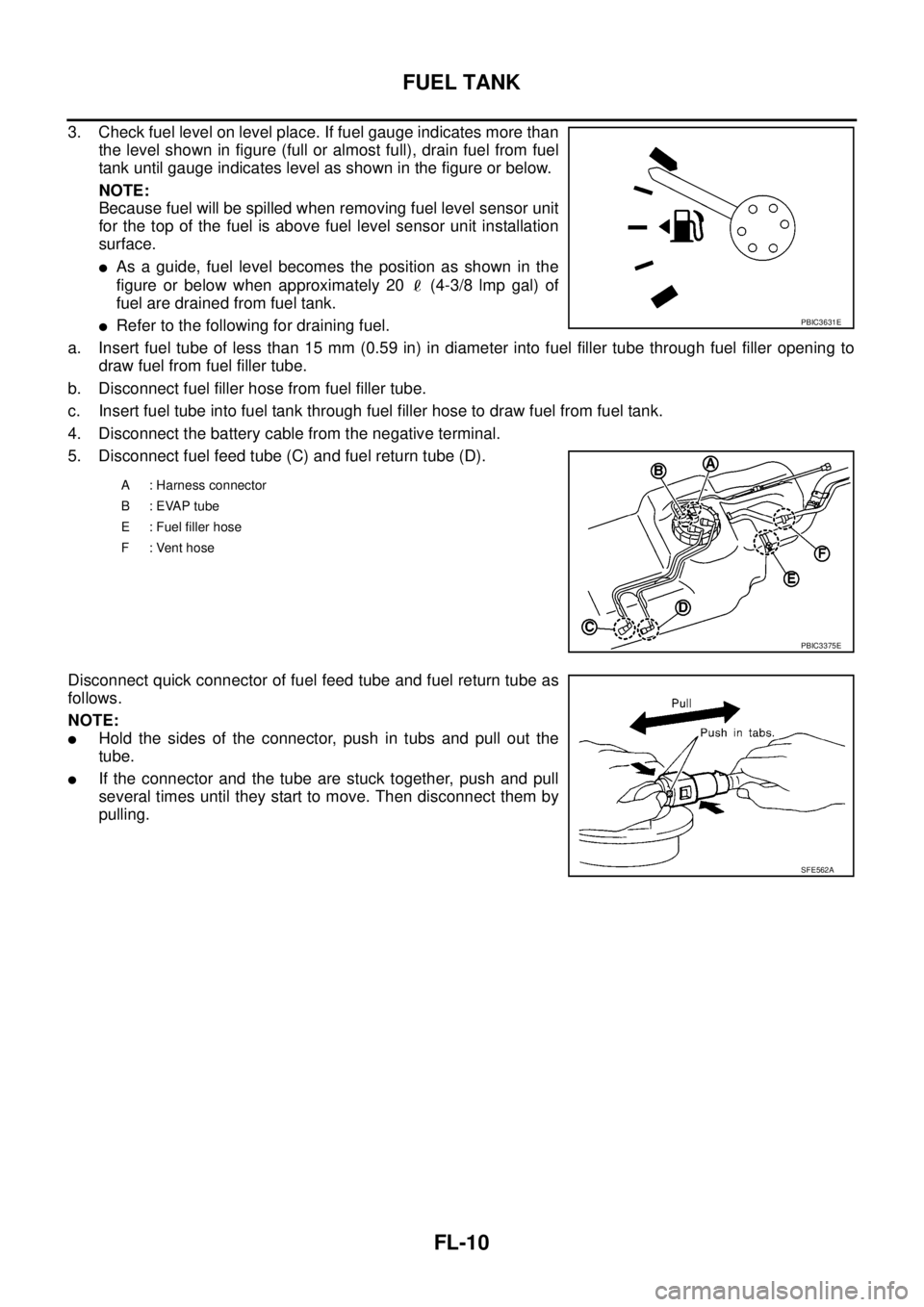
FL-10
FUEL TANK
3. Check fuel level on level place. If fuel gauge indicates more than
the level shown in figure (full or almost full), drain fuel from fuel
tank until gauge indicates level as shown in the figure or below.
NOTE:
Because fuel will be spilled when removing fuel level sensor unit
for the top of the fuel is above fuel level sensor unit installation
surface.
lAs a guide, fuel level becomes the position as shown in the
figure or below when approximately 20 (4-3/8 lmp gal) of
fuel are drained from fuel tank.
lRefer to the following for draining fuel.
a. Insert fuel tube of less than 15 mm (0.59 in) in diameter into fuel filler tube through fuel filler opening to
draw fuel from fuel filler tube.
b. Disconnect fuel filler hose from fuel filler tube.
c. Insert fuel tube into fuel tank through fuel filler hose to draw fuel from fuel tank.
4. Disconnect the battery cable from the negative terminal.
5. Disconnect fuel feed tube (C) and fuel return tube (D).
Disconnect quick connector of fuel feed tube and fuel return tube as
follows.
NOTE:
lHold the sides of the connector, push in tubs and pull out the
tube.
lIf the connector and the tube are stuck together, push and pull
several times until they start to move. Then disconnect them by
pulling.
A : Harness connector
B : EVAP tube
E : Fuel filler hose
F : Vent hose
PBIC3631E
PBIC3375E
SFE562A
Page 1595 of 3171
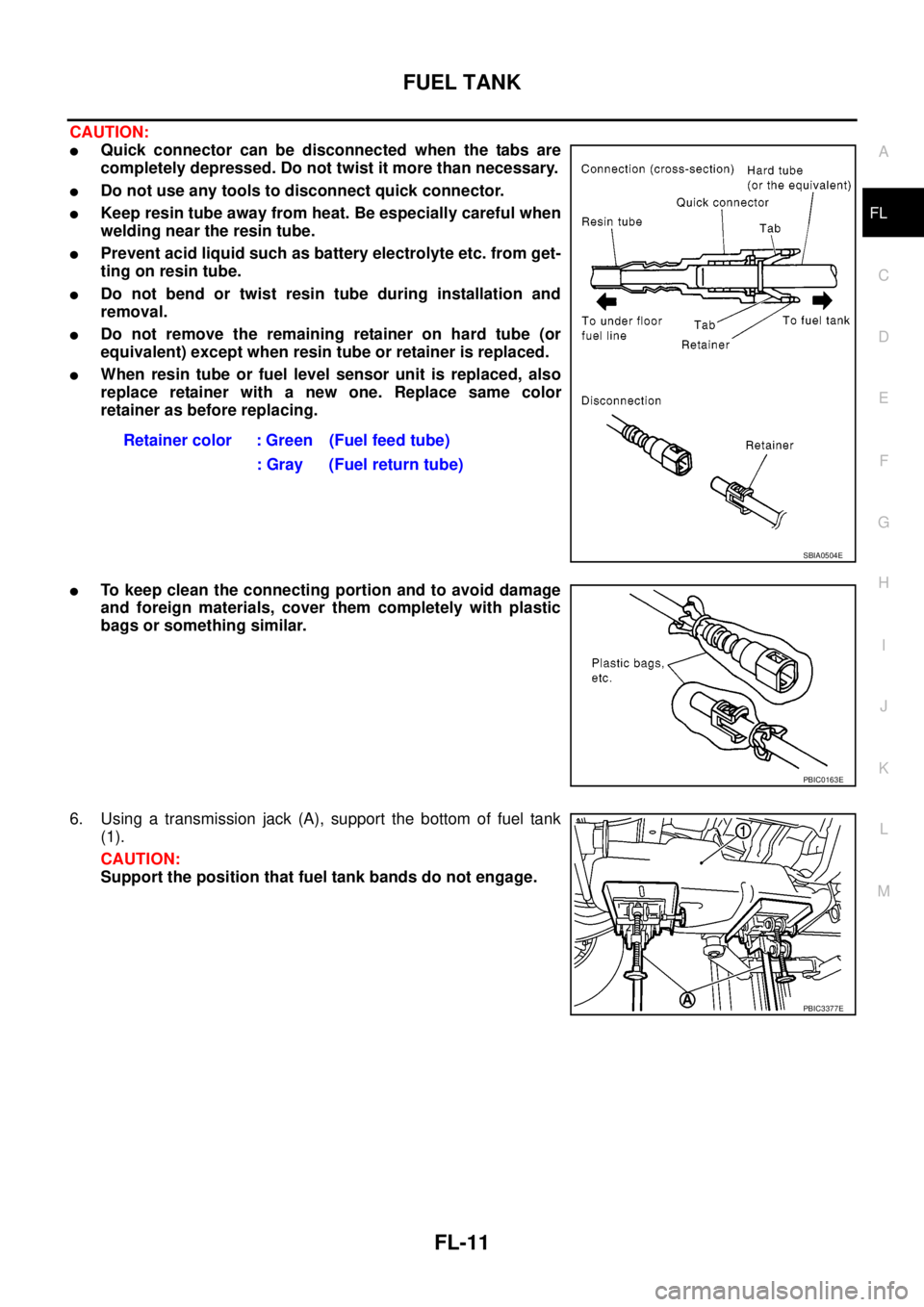
FUEL TANK
FL-11
C
D
E
F
G
H
I
J
K
L
MA
FL
CAUTION:
lQuick connector can be disconnected when the tabs are
completely depressed. Do not twist it more than necessary.
lDo not use any tools to disconnect quick connector.
lKeep resin tube away from heat. Be especially careful when
welding near the resin tube.
lPrevent acid liquid such as battery electrolyte etc. from get-
ting on resin tube.
lDo not bend or twist resin tube during installation and
removal.
lDo not remove the remaining retainer on hard tube (or
equivalent) except when resin tube or retainer is replaced.
lWhen resin tube or fuel level sensor unit is replaced, also
replace retainer with a new one. Replace same color
retainer as before replacing.
lTo keep clean the connecting portion and to avoid damage
and foreign materials, cover them completely with plastic
bags or something similar.
6. Using a transmission jack (A), support the bottom of fuel tank
(1).
CAUTION:
Support the position that fuel tank bands do not engage.Retainer color : Green (Fuel feed tube)
: Gray (Fuel return tube)
SBIA0504E
PBIC0163E
PBIC3377E
Page 1598 of 3171
FL-14
FUEL LEVEL SENSOR UNIT
FUEL LEVEL SENSOR UNIT
PFP:17042
ComponentsEBS01F6N
lRefer toGI-10, "Components"for symbol marks in the figure.
Removal and InstallationEBS01E76
REMOVAL
WARNING:
Be sure to read “General Precautions” when working on fuel system. Refer toFL-3, "
General Precau-
tions".
1. Remove fuel tank from the vehicle. Refer toFL-9, "
FUEL TANK".
2. Using a fuel tank lock ring wrench (commercial service tool),
remove the lock ring.
3. Remove fuel level sensor unit.
CAUTION:
lDo not bend the float arm during removal.
lAvoid impacts such as falling when handling components.
INSPECTION AFTER REMOVAL
Make sure fuel level sensor unit is free from foreign materials. If any are found, remove them.
1. Lock ring 2. Fuel level sensor unit 3. Seal packing
4. Fuel tank
A. Refer to text.
PBIC3374E
PBIC0240E
Page 1599 of 3171
FUEL LEVEL SENSOR UNIT
FL-15
C
D
E
F
G
H
I
J
K
L
MA
FL
INSTALLATION
Note the following, and install in the reverse order of removal.
lInstall fuel level sensor unit (1) with aligning mating marks (A) on
fuel tank and fuel level sensor unit as shown in the figure.
lInstall lock ring (1), and tighten lock ring by hand. Then tighten
lock ring with a fuel tank lock ring wrench (commercial service
tool), aligning mating marks (A) on fuel tank and lock ring as
showninthefigure.
INSPECTION AFTER INSTALLATION
Make sure there is no fuel leakage at connections in the following steps.
lStart engine and rev it up and make sure there is no fuel leakage at connections.
: Vehicle front
PBIC3506E
: Vehicle front
PBIC3632E
Page 1616 of 3171
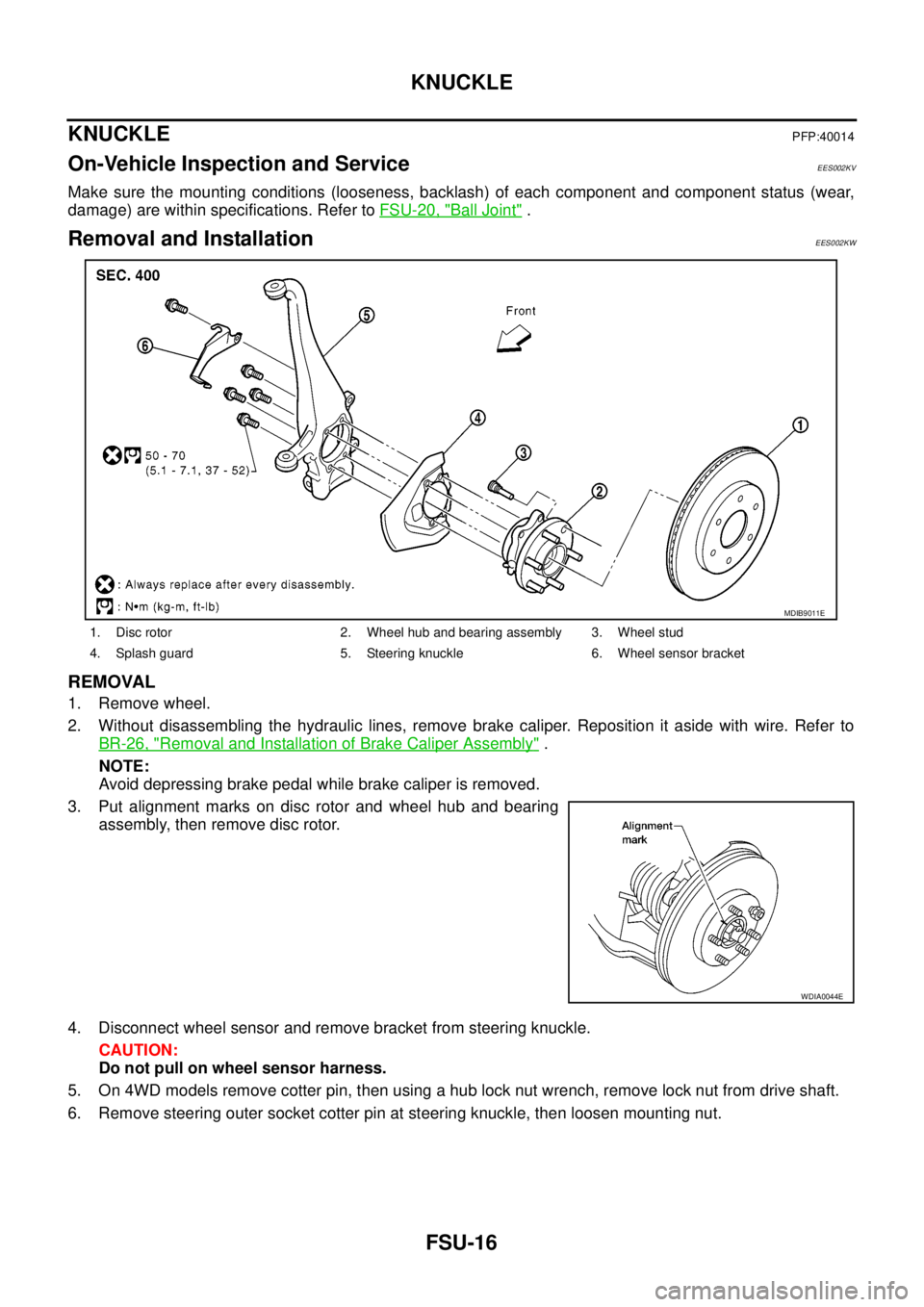
FSU-16
KNUCKLE
KNUCKLE
PFP:40014
On-Vehicle Inspection and ServiceEES002KV
Make sure the mounting conditions (looseness, backlash) of each component and component status (wear,
damage) are within specifications. Refer toFSU-20, "
Ball Joint".
Removal and InstallationEES002KW
REMOVAL
1. Remove wheel.
2. Without disassembling the hydraulic lines, remove brake caliper. Reposition it aside with wire. Refer to
BR-26, "
Removal and Installation of Brake Caliper Assembly".
NOTE:
Avoid depressing brake pedal while brake caliper is removed.
3. Put alignment marks on disc rotor and wheel hub and bearing
assembly, then remove disc rotor.
4. Disconnect wheel sensor and remove bracket from steering knuckle.
CAUTION:
Do not pull on wheel sensor harness.
5. On 4WD models remove cotter pin, then using a hub lock nut wrench, remove lock nut from drive shaft.
6. Remove steering outer socket cotter pin at steering knuckle, then loosen mounting nut.
1. Disc rotor 2. Wheel hub and bearing assembly 3. Wheel stud
4. Splash guard 5. Steering knuckle 6. Wheel sensor bracket
MDIB9011E
WDIA0044E